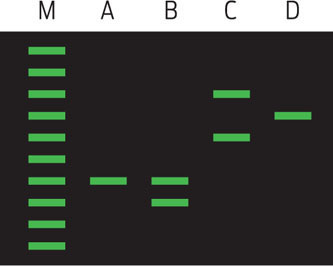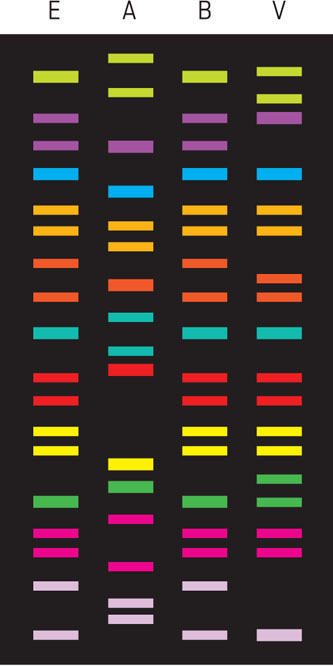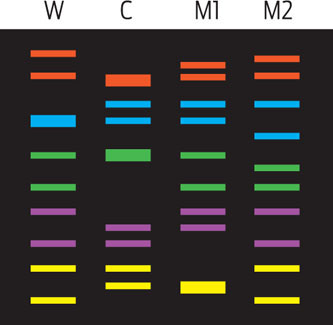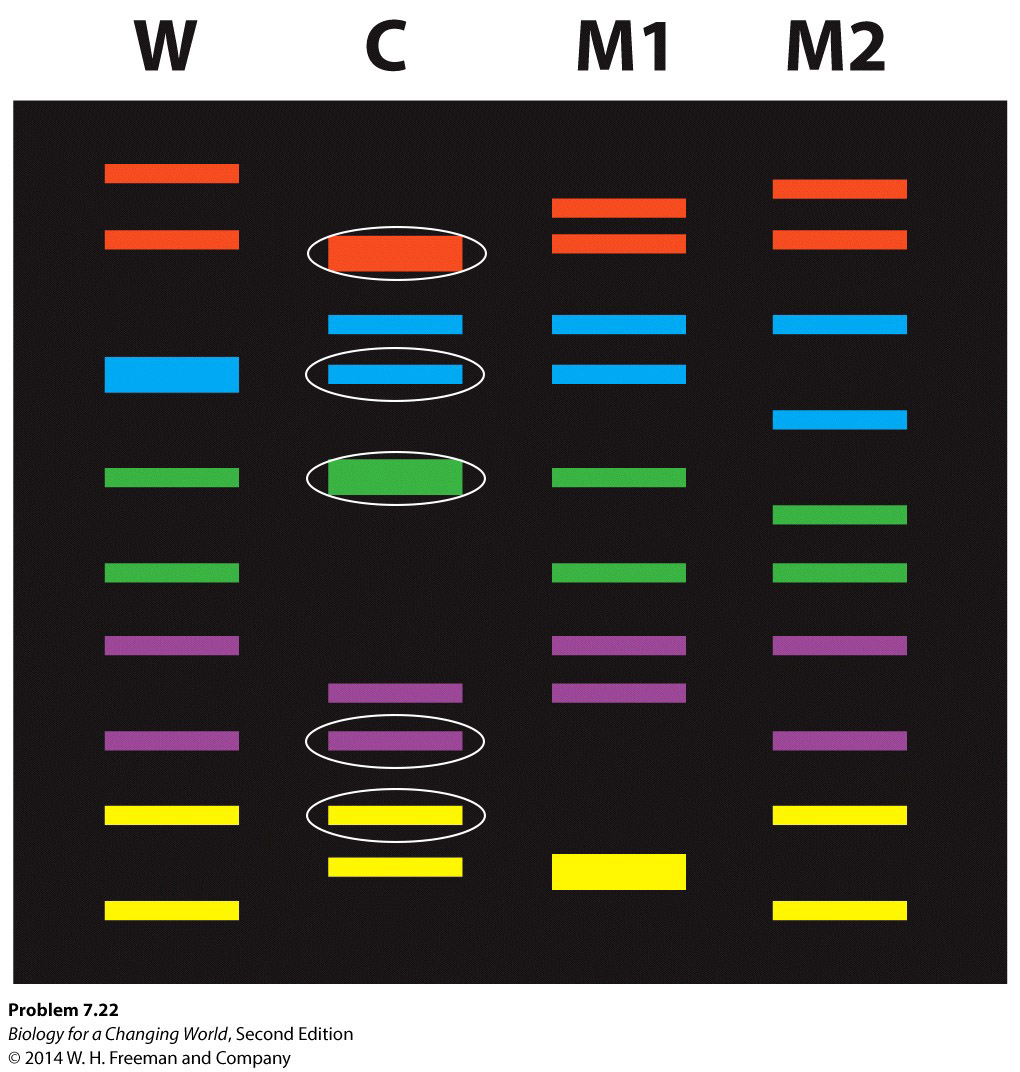CHAPTER 7 Test Your Knowledge
DRIVING QUESTION 1
What is the structure of DNA, and how is DNA organized in cells?
By answering the questions below and studying Infographics 7.1 and 7.2, you should be able to generate an answer for the broader Driving Question above.
KNOW IT
 Which of the following is not a nucleotide found in DNA?
Which of the following is not a nucleotide found in DNA?
a. adenine (A)
b. thymine (T)
c. cytosine (C)
d. guanine (G)
e. uracil (U)
e
 If the sequence of one strand of DNA is AGTCTAGC, what is the sequence of the complementary strand?
If the sequence of one strand of DNA is AGTCTAGC, what is the sequence of the complementary strand?
a. AGTCTAGC
b. CGATCTGA
c. TCAGATCG
d. GTCGACGC
e. GCTAGACT
c
 In addition to the base, what are the other components of a nucleotide?
In addition to the base, what are the other components of a nucleotide?
a. sugar and polymerase
b. phosphate and sugar
c. phosphate and polymerase
d. phosphate and helix
e. helix and sugar
b
 The_______chromosomes in a human cell from inside the cheek are found in the_____.
The_______chromosomes in a human cell from inside the cheek are found in the_____.
a. 46; cytoplasm
b. 23; nucleus
c. 24; cytoplasm
d. 46; nucleus
e. 22; nucleus
d
 Each chromosome contains
Each chromosome contains
a. DNA only.
b. proteins only.
c. DNA and proteins.
d. the same number of genes and STRs.
e. the entire genome of a cell.
c
USE IT
 You can detect DNA that is specifically from the x chromosome in a DNA sample from a person. Can you definitively determine the sex of that person (male or female) from the presence of the x chromosome? Explain your answer.
You can detect DNA that is specifically from the x chromosome in a DNA sample from a person. Can you definitively determine the sex of that person (male or female) from the presence of the x chromosome? Explain your answer.
No. Both males and females have one X chromosome in all of their somatic cells. The presence of a Y chromosome would definitively indicate a male.
 Human red blood cells are enucleated (that is, they do not have nuclei). Is it possible to isolate DNA from red blood cells? Why or why not?
Human red blood cells are enucleated (that is, they do not have nuclei). Is it possible to isolate DNA from red blood cells? Why or why not?
No. As all of the DNA found in the 46 chromosomes in the genome of our cells is contained in the nucleus, we cannot use red blood cells to isolate any of this DNA.
DRIVING QUESTION 2
How is DNA copied in living cells, and how can DNA be amplified for forensics?
By answering the questions below and studying Infographics 7.3 and 7.4, you should be able to generate an answer for the broader Driving Question above.
KNOW IT
 DNA replication is said to be semiconservative because a newly replicated, double-stranded DNA molecules consists of
DNA replication is said to be semiconservative because a newly replicated, double-stranded DNA molecules consists of
a. two old strands.
b. two new strands.
c. one old strand and one new strand.
d. two strands, each with a mixture of old and new DNA.
e. any of the above, depending on the cell type
c
 Which of the following statements about PCR is true?
Which of the following statements about PCR is true?
a. DNA polymerase is the enzyme that copies DNA in PCR.
b. Primers are not necessary for PCR.
c. PCR does not require nucleotides.
d. PCR does not generate a complementary DNA strand.
e. PCR can make only a few copies of a DNA molecule.
a
USE IT
 Complete the statements below, and then number them to indicate the order of these two major steps necessary to copy a DNA sequence during PCR.
Complete the statements below, and then number them to indicate the order of these two major steps necessary to copy a DNA sequence during PCR.
_______The enzyme________”reads” each template strand and adds complementary nucleotides to make a new strand.
_______The two original strands of the DNA molecule can be separated by_________.
(2) The enzyme DNA polymerase “reads” each template strand and adds complementary nucleotides to make a new strand.
(1) The two original strands of the DNA molecule can be separated by heat.
 Given this segment of a double-stranded DNA molecule, draw the two major steps involved in DNA replication:
Given this segment of a double-stranded DNA molecule, draw the two major steps involved in DNA replication:
ATCGGCTAGCTACGGCTATTTACGGCATAT
TAGCCGATCGATGCCGATAAATGCCGTATA
Step 1. The strands separate (following heating):ATCGGCTAGCTACGGCTATTTACGGCATATTAGCCGATCGATGCCGATAAATGCCGTATAStep 2. Primers bind (by complementary base pairing) toward the end of each single strand.
Step 3. DNA polymerase copies each strand; the primer is the starting point. The result is two identical double-stranded DNA molecules.ATCGGCTAGCTACGGCTATTTACGGCATATTAGCCGATCGATGCCGATAAATGCCGTATAATCGGCTAGCTACGGCTATTTACGGCATATTAGCCGATCGATGCCGATAAATGCCGTATAStep 4. Steps 1–3 are repeated, increasing the number of DNA products with each cycle.
DRIVING QUESTION 3
How does DNA profiling make use of genetic variation in DNA sequences?
By answering the questions below and studying Infographics 7.5, 7.6, and 7.7, you should be able to generate an answer for the broader Driving Question above.
KNOW IT
 Which STR will have migrated farthest through an electrophoresis gel?
Which STR will have migrated farthest through an electrophoresis gel?
a. GAAG repeated twice
b. GAAG repeated three times
c. AGCT repeated five times
d. GAAG repeated seven times
e. AGCT repeated seven times
a
 An individual’s STR may vary from the same STR of another individual by
An individual’s STR may vary from the same STR of another individual by
a. the order of nucleotides.
b. the specific bases present.
c. the specific chromosomal location of the STR.
d. the number of times a particular sequence is repeated.
e. the number of coding regions.
d
 Which of the following represents genetic variation between individuals?
a. whether or not G pairs with C or T
Which of the following represents genetic variation between individuals?
a. whether or not G pairs with C or T
b. the presence of STRs in their genomes
c. the number of chromosomes in the nucleus
d. the sequence of nucleotides along the length of each chromosome
e. the number of chromosomes received from each parent
d

 A person has an STR with the sequence GACCT repeated six times on one chromosome and eight times on the other chromosome. If this STR were amplified by PCR, and the PCR products run on a gel, which lane would show the corresponding banding pattern (see gel at top right)? The marker lane (M) has fragments starting at 10 nucleotides (at the bottom) and increasing in 10-nucleotide increments.
A person has an STR with the sequence GACCT repeated six times on one chromosome and eight times on the other chromosome. If this STR were amplified by PCR, and the PCR products run on a gel, which lane would show the corresponding banding pattern (see gel at top right)? The marker lane (M) has fragments starting at 10 nucleotides (at the bottom) and increasing in 10-nucleotide increments.
lane B
USE IT
152
 A series of statements is presented below. Mark each statement as true (T) or false (F).
A series of statements is presented below. Mark each statement as true (T) or false (F).
a. ______ G pairs with T
b. _______ Genetic information is passed on to the next generation in the form of DNA molecules.
c. _____ All DNA sequences encode information to produce proteins.
d. _____ Each person carries the same number of STR repeats on both maternal and paternal chromosomes.
e. ______ DNA evidence can be obtained from saliva left in a bite mark.
a: F; b: T; c: F; d: F; e: T
 Explain why the statements that you marked as true in Question 16 are in fact true.
Explain why the statements that you marked as true in Question 16 are in fact true.
DNA is the genetic/hereditary information in humans. DNA is found in nearly all our cells, and can be extracted from blood, semen, saliva, and hair.
 Rewrite the statements that you marked as false in Question 16 to make them true.
Rewrite the statements that you marked as false in Question 16 to make them true.
G pairs with C and A pairs with T. Some DNA sequences carry information to encode proteins, but some DNA sequences do not—for example, noncoding regions (see Chapter 8) do not carry information that encodes proteins. The number of times an STR is repeated can vary between different alleles, therefore each person can have different length STRs on their maternal and paternal chromosomes.
DRIVING QUESTION 4
How does DNA Evidence fit into forensic investigations?
By answering the questions below and studying Infographics 7.1, 7.5, 7.6, and 7.7, you should be able to generate an answer for the broader Driving Question above.
153
KNOW IT
 The gel at right shows the DNA profile of STRs from four sources: blood from crime scene evidence (E), suspect A, suspect B, and the victim (v). An eyewitness identified suspect A as fleeing the apartment building where the crime occurred. Suspect B was picked up at a local convenience store after using bloodstained money.
The gel at right shows the DNA profile of STRs from four sources: blood from crime scene evidence (E), suspect A, suspect B, and the victim (v). An eyewitness identified suspect A as fleeing the apartment building where the crime occurred. Suspect B was picked up at a local convenience store after using bloodstained money.
a. From the DNA profiles shown, can you draw any conclusions about where the crime scene DNA came from?
b. Can you draw any conclusions about relationships among the people profiled? Explain your reasoning.

a: Suspect B’s profile matches the evidence at all markers tested. Suspect B is more than likely the source of the DNA evidence at the crime scene. b: Suspect B is likely to be related to the victim, as suspect B shares at least one band with the victim at every allele tested. Suspect B could be the parent or child of the victim.
USE IT
 Look at Infographic 7.7. From the STRs used in forensic investigations, which STRs on which chromosomes would be particularly useful in determining whether crime scene evidence was left by a female or a male?
Look at Infographic 7.7. From the STRs used in forensic investigations, which STRs on which chromosomes would be particularly useful in determining whether crime scene evidence was left by a female or a male?

AMELX and AMELY
 Explain your response to Question 20, stating the number of STR copies you would expect to see if the perpetrator was female and if the perpetrator was male.
Explain your response to Question 20, stating the number of STR copies you would expect to see if the perpetrator was female and if the perpetrator was male.
AMELX is a marker on the X chromosome. A female perpetrator would have at least one band for AMELX and no bands for AMELY. For a male perpetrator, they would have one AMELX and one AMELY band.
 The gel below shows a DNA profile using five STRs. The lane labeled W is a mother and the lane labeled C is her child. The lanes labeled M1 and M2 are two men, either of whom, according to the mother, could be the father of the child.
The gel below shows a DNA profile using five STRs. The lane labeled W is a mother and the lane labeled C is her child. The lanes labeled M1 and M2 are two men, either of whom, according to the mother, could be the father of the child.
a. Circle the STR bands that the child (C) inherited from its mother (W).
b. Use the DNA profiles to determine which man is the father of the child.
a.
b. M1 is the father.
INTERPRETING DATA
 The table below shows the frequencies for STR lengths (repeat number) in different U.S. populations. You can determine the probability of a particular combination of STRs by multiplying the frequencies: for example, the probability of a Hispanic person’s having 14 D3S1358 repeats (0.079) and 18 TH01 repeats (0.125) is 0.079 x 0.125 = 0.009
The table below shows the frequencies for STR lengths (repeat number) in different U.S. populations. You can determine the probability of a particular combination of STRs by multiplying the frequencies: for example, the probability of a Hispanic person’s having 14 D3S1358 repeats (0.079) and 18 TH01 repeats (0.125) is 0.079 x 0.125 = 0.009
a. What is the probability of a Caucasian American’s having a 16, 17 combination for D3S1358?
b. What is the probability of an African American’s having a 16, 17 combination for D3S1358?
c. What is the probability of an Hispanic American’s having a 16, 17 combination for D3S1358?
d. What is the probability of a Caucasian American’s having a 16, 17 combination for D3S1358, and a 5, 9 combination for TH01?
e. What is the probability of a Caucasian American’s having a 16, 17 combination for D3S1358, a 5, 9 combination for TH01 and an 11, 14 combination for D18S51?
f. Consider your answers to a, d, and e. Why does forensic analysis use many CODIS markers (and not just one or two)?
a: 0.200 × 0.281 = 0.0562; b: 0.248 × 0.22 = 0.055; c: 0.286 × 0.204 = 0.058; d: (0.200 × 0.281) × (0.002 × 0.114) = 0.000013; e: (0.200 × 0.281) × (0.002 × 0.114) × (0.017 × 0.137) = ~0.000000030; f: The more CODIS markers that are used, the less likely it is that any two samples will match by chance alone.
Data from Butler et al. (2003) Allele frequencies for 15 autosomal STR loci on U.S. Caucasian, African American and Hispanic populations. Journal of Forensic Sciences 48(4): 908–911.
*CODIS stands for “Combined DNA Index System,” a government database of DNA profiles from offenders, crime scenes, and missing persons.
MINI CASE
 A female eyewitness has identified a Hispanic American male as the man who stole her car. The eyewitness stated that the man was bleeding profusely from a head wound. Her car was recovered, and male blood with a 16, 17 combination for D3S1358, a 5, 9 combination for TH01, and an 11, 14 combination for D18S51 was found on the driver’s seat and steering wheel. Does this finding call the eyewitness evidence into question? Explain your answer.
A female eyewitness has identified a Hispanic American male as the man who stole her car. The eyewitness stated that the man was bleeding profusely from a head wound. Her car was recovered, and male blood with a 16, 17 combination for D3S1358, a 5, 9 combination for TH01, and an 11, 14 combination for D18S51 was found on the driver’s seat and steering wheel. Does this finding call the eyewitness evidence into question? Explain your answer.
Because the 5 allele for TH01 does not occur in Hispanic Americans, it is exceedingly unlikely that the eyewitness has accurately identified the person who stole her car.
BRING IT HOME
 Scientists used DNA from Barry Bench’s daughter to pinpoint Bench as a possible suspect, as his DNA was not on file anywhere. Similarly, in cases of disasters, DNA evidence is sometimes required to identify victims. If a victim doesn’t have a DNA profile on file, identity must be reconstructed by comparing the victim’s DNA profile to that of relatives. These situations illustrate that a DNA profile database has the potential to be useful in cases in which DNA-based identification is required. However, maintenance of such a database is controversial. What arguments can you make for and against banking DNA profiles in a database? If such a database existed, what restrictions would you place on it? Would you choose to register your DNA or your child’s DNA in such a database?
Scientists used DNA from Barry Bench’s daughter to pinpoint Bench as a possible suspect, as his DNA was not on file anywhere. Similarly, in cases of disasters, DNA evidence is sometimes required to identify victims. If a victim doesn’t have a DNA profile on file, identity must be reconstructed by comparing the victim’s DNA profile to that of relatives. These situations illustrate that a DNA profile database has the potential to be useful in cases in which DNA-based identification is required. However, maintenance of such a database is controversial. What arguments can you make for and against banking DNA profiles in a database? If such a database existed, what restrictions would you place on it? Would you choose to register your DNA or your child’s DNA in such a database?
The advantages of a DNA bank include the means to exonerate suspects who have been wrongly convicted and helping to identify suspects of crimes and victims of disasters. However, there are some risks, depending on the how the information is used. A person’s DNA can also reveal susceptibility to certain diseases, some of which are incurable, or to previously unsuspected questions of paternity. For these reasons, many have argued that DNA profiles go beyond identification in the same way that fingerprints do. Many people choose to be genotyped when they register to be bone marrow donors, but they may not wish their genetic information to be used for other purposes. Answers will vary with respect to recommendations and willingness to register in a DNA database.